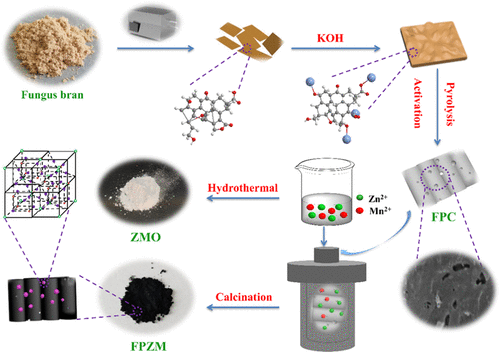当前位置:
X-MOL 学术
›
J. Phys. Chem. C
›
论文详情
Our official English website, www.x-mol.net, welcomes your feedback! (Note: you will need to create a separate account there.)
Fungus Bran-Derived Porous N-Doped Carbon–Zinc Manganese Oxide Nanocomposite Positive Electrodes toward High-Performance Asymmetric Supercapacitors
The Journal of Physical Chemistry C ( IF 3.7 ) Pub Date : 2020-06-17 , DOI: 10.1021/acs.jpcc.0c03098 Keqi Qu 1 , Yue You 1 , Houjuan Qi 1 , Cai Shi 1 , Zhe Sun 1 , Zhanhua Huang 1 , Bingnan Yuan 1, 2 , Zhanhu Guo 2
The Journal of Physical Chemistry C ( IF 3.7 ) Pub Date : 2020-06-17 , DOI: 10.1021/acs.jpcc.0c03098 Keqi Qu 1 , Yue You 1 , Houjuan Qi 1 , Cai Shi 1 , Zhe Sun 1 , Zhanhua Huang 1 , Bingnan Yuan 1, 2 , Zhanhu Guo 2
Affiliation

|
The common forest waste fungus bran (FB) having the advantages of sustainability, abundance, and availability was used to produce carbon products or carbon matrix hosting composites. The existing abundant nitrogen in FB served as a dopant to in situ dope the formed carbon skeleton. The FB-derived N-doped carbon product was porous (named FPC) and displayed flake structures. Its specific surface area was up to 1515 m2 g–1 and had a suitable pore size distribution. This FPC electrode showed a promising capacity of 380 F g–1 at a current density of 1 A g–1. The composite was fabricated using FPC as a template to in situ form the zinc manganese oxide (ZMO) nanocubes at different ratios (the composites are denoted FPZM), and the corresponding as-prepared composites (with an FPC-to-ZMO ratio of 1:3) electrode displayed a higher charge capacitance of 537 F g–1 at 1 A g–1 and favorable cycle performance. The energy density of an asymmetric device with composite electrode as the positive electrode and FPC as the negative electrode was 13.54 Wh kg–1 at 700.34 W kg–1. The synergistic effect between the biomass-derived carbon and pseudocapacitive oxides gave an improved energy-storage performance. Our experimental results show that the forest waste can be effectively utilized as an activated carbon material for wide applications.
中文翻译:

真菌麸皮衍生的多孔N掺杂碳锌锰氧化物纳米复合正电极,用于高性能非对称超级电容器
具有可持续性,丰富性和可用性的优势的普通森林废木耳糠(FB)被用于生产碳产品或碳基质承载复合材料。FB中现有的丰富氮用作掺杂剂,以原位掺杂形成的碳骨架。FB衍生的N掺杂碳产物是多孔的(称为FPC),并显示出薄片结构。其比表面积高达1515 m 2 g –1,并具有合适的孔径分布。该FPC电极显示出380 F G有希望的容量-1在1A g的电流密度-1。以FPC为模板制造复合材料,以不同比例原位形成锌锰氧化物(ZMO)纳米立方体(复合材料表示为FPZM),并制备相应的复合材料(FPC与ZMO的比例为1 :3)电极在1 A g –1时显示出更高的537 F g –1充电电容,并具有良好的循环性能。非对称装置与复合电极作为正极和FPC作为负极是13.54瓦千克的能量密度-1在700.34W¯¯千克-1。生物质衍生的碳和假电容性氧化物之间的协同作用提高了储能性能。我们的实验结果表明,森林废弃物可以有效地用作活性炭材料,得到广泛应用。
更新日期:2020-07-23
中文翻译:

真菌麸皮衍生的多孔N掺杂碳锌锰氧化物纳米复合正电极,用于高性能非对称超级电容器
具有可持续性,丰富性和可用性的优势的普通森林废木耳糠(FB)被用于生产碳产品或碳基质承载复合材料。FB中现有的丰富氮用作掺杂剂,以原位掺杂形成的碳骨架。FB衍生的N掺杂碳产物是多孔的(称为FPC),并显示出薄片结构。其比表面积高达1515 m 2 g –1,并具有合适的孔径分布。该FPC电极显示出380 F G有希望的容量-1在1A g的电流密度-1。以FPC为模板制造复合材料,以不同比例原位形成锌锰氧化物(ZMO)纳米立方体(复合材料表示为FPZM),并制备相应的复合材料(FPC与ZMO的比例为1 :3)电极在1 A g –1时显示出更高的537 F g –1充电电容,并具有良好的循环性能。非对称装置与复合电极作为正极和FPC作为负极是13.54瓦千克的能量密度-1在700.34W¯¯千克-1。生物质衍生的碳和假电容性氧化物之间的协同作用提高了储能性能。我们的实验结果表明,森林废弃物可以有效地用作活性炭材料,得到广泛应用。


























 京公网安备 11010802027423号
京公网安备 11010802027423号